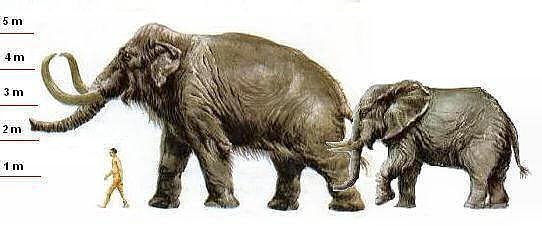
December 10, 2008
What is the largest mammoth to be found in the fossil record, thus far? Does it tell us something about others, which may have yet to be discovered? What does it say about the landscape of the times, in specific locations? And in a world of large elephants, what kind of large primates might be unearthed in the future?

H. sapiens, Songhua River Mammoth, African Elephant (Image: Asiertxo)
Let’s survey the background new info available online about this apparently remarkable mammoth.
The largest elephant that ever lived [as far as is known today] was huge, taller than a two-story house and almost as tall as the average telephone pole. Evolved from smaller Siberian mammoths, the Songhua River Mammoth (Mammuthus sungari) roamed Northern China and Inner Mongolia during the Middle Pleistocene about 280,000 years ago. It survived into the Late Pleistocene but died out well before the end of the last ice age [unless some of the 1920s’ cryptid reports were reality].
Fossils of the Songhua River Mammoth are rare. The largest mammals in any group are never common because several factors set limits on population numbers. An elephant of this size would have a long maturation period, and breed slowly with only one or two offspring born at one time. Daily caloric requirements – pounds of grass and other fodder – would be huge and require that these huge beasts eat continuously 24/7.
There is an original Songhua River Mammoth in the Inner Mongolia Museum, which was constructed from the remains of two individuals. A skeleton of a large male in a Japanese museum is 17 ft tall and 30 ft long from tip of the trunk to tip of the tail. Estimated weight is 10 tonnes and the metrics of this huge male represent maximum size for the Songhua River Mammoth.
In China, there is a Songhua Mammoth skeleton on exhibit at the Daging Museum that is a 13-14 year old male from the late Upper Pleistocene with a body length of 6m and height of 3.5m. It was found in 2003 and is nearly identical to that in a museum in Shenzhen. Remains of more than 150 Songhua River Mammoths have been found in China, but most of the fossil evidence is bits and pieces, fragments of teeth, limb bones and the skull.
There were scattered human groups in Northern China at the time of the Songhua River Mammoth. Archeologists in Africa working on early human ancestor sites have established that the biggest elephants in Africa were occasionally hunted and we can assume that was also true for Pleistocene hunters in China and Mongolia. The effort and danger were worth it – one successful elephant hunt and the clan had food for weeks and materials for their toolbox.
What else might be out there?
Thanks to DWA for the stimulus for continuing to attempt a revised opening that was not at first uploaded due to remote location internet problems.
About Loren Coleman
Loren Coleman is one of the world’s leading cryptozoologists, some say “the” leading living cryptozoologist. Certainly, he is acknowledged as the current living American researcher and writer who has most popularized cryptozoology in the late 20th and early 21st centuries.
Starting his fieldwork and investigations in 1960, after traveling and trekking extensively in pursuit of cryptozoological mysteries, Coleman began writing to share his experiences in 1969. An honorary member of Ivan T. Sanderson’s Society for the Investigation of the Unexplained in the 1970s, Coleman has been bestowed with similar honorary memberships of the North Idaho College Cryptozoology Club in 1983, and in subsequent years, that of the British Columbia Scientific Cryptozoology Club, CryptoSafari International, and other international organizations. He was also a Life Member and Benefactor of the International Society of Cryptozoology (now-defunct).
Loren Coleman’s daily blog, as a member of the Cryptomundo Team, served as an ongoing avenue of communication for the ever-growing body of cryptozoo news from 2005 through 2013. He returned as an infrequent contributor beginning Halloween week of 2015.
Coleman is the founder in 2003, and current director of the International Cryptozoology Museum in Portland, Maine.
Filed under Breaking News, Cryptotourism, CryptoZoo News, Cryptozoologists, Cryptozoology, Extinct, Megafauna